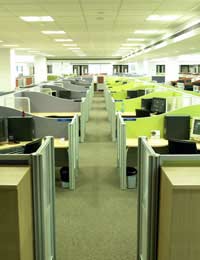Changing Working Practices To Save Energy

As anyone who has performed some simple time and motion exercises at work will agree, it takes very little in terms of change to effectively improve the efficiency of your work place: By simply moving equipment around you can reduce the time and effort (motion) required to get a job done.
Overall the savings in terms of time and physical effort amount to huge savings (and then profits) financially. Not heeding this simple logic can be the difference between success and failure as a company.
Significantly, the very same factors can have a large impact on the amount of carbon you use, as all energy expenditure (even in terms of human energy expended) uses carbon at some point along the line: every human will expend energy that needs replacing (by eating, entailing the production of food), they will need to use transportation sometimes and so on.
What a look to factors around time and motion also demonstrates is that elements that are often overlooked can in fact be the difference between financial success and ruin, and in this respect any company however large or small will do well to examine not only time and motion expenditure in terms of employee exertion, but also to look at energy expended across the company in terms of carbon output, as that too will save large amounts of money .
Examining Your Work Practices
In examining time and motion within the work place it is vital to leave no stone unturned. The distance for each worker from their desk to the store cupboard (for example) is as relevant as the distance and time involved in a simple or complex working process.Spend time with each employee looking at their daily routine, especially at routine tasks. Remember that whilst a worker may only have to stock up on materials every 30 minutes, if it takes ten minutes to do so that is 120 minutes of working day lost that will have to be recuperated somehow.
In terms of carbon emissions you may also to look at how workers get through the day in terms of energy usage: do they, for example, use machinery that can be turned off when they are away from it, and would that actually be beneficial in terms of total energy output (some machines consume more energy in start up than whilst running)?
Be sure again to look at every single aspect of the working day: If your workers drive during work, make sure the most efficient and most environmentally friendly fuel is used where possible and make sure they drive in the most efficient way, avoiding both low gears and high speeds so far as possible (see related article entitled ‘Your Fleet’ for further details).
Also be sure to look at overall company policy: are monitors and computers left on, or on standby, overnight, are lights left on unnecessarily, and so on. Use energy efficient light bulbs and if you have any white goods use the ones labelled as most energy efficient.
By combining a careful study of the best use of time and motion with an examination of energy usage you will effectively streamline your company, making it not only environmentally friendly (something that benefits you both in the eyes of the customers and the authorities) but also highly competitive.
- Energy Help for Your Business Sector
- Save Energy, Make Money
- Saving Water to Help Prevent Climate Change
- Financial Help Towards Saving Energy
- Addressing Climate Change in Your Transport Policy
- Building Insulation & The Effect On Climate Change
- Power Generation & Climate Change
- The Importance of Using Less Paper in the Workplace


Re: Cavity Wall Insulation and Energy Saving
Extremely interesting. Thank you for giving such an informative blog.
Re: Cavity Wall Insulation and Energy Saving
Wow, that was incredible. This is an excellent post. Thank you for sharing this information.
Re: Cavity Wall Insulation and Energy Saving
You delivered it so well. I hope you make some more of this article. Thank you.
Re: Cavity Wall Insulation and Energy Saving
Thanks for making this web-site, and I’ll be visiting again.
Re: What is Being Done to Stop Climate Change?
we should stop eating beans because the more we fart the more destructive gasses are released into the…
Re: What is Being Done to Stop Climate Change?
I just read that upto 51% of emissions come from animal agriculture. Not eating animal products for breakfast…
Re: What is Being Done to Stop Climate Change?
WHY WONT PEOPLE DO ANYTHING ABOUT CLIMATE CHANGE, all these stupid millionaires and billionaires living their…
Re: How can we Prevent Climate Change?
Climate change is a hoax made by Obama. The "climate change" is not real, just go outside, why is it cold there,…
Re: The Importance of Using Less Paper in the Workplace
I have stopped using paper and disposable plastic in my house. Washable Rags instead of toilet…
Re: How can we Prevent Climate Change?
Let me start by saying thanks for the education on climate change. I would appreciate if you provide my organization the…